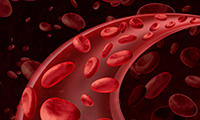Obizur
A Life Saving Treatment for Acquired Hemophilia Twenty Years in the Making
As stories in the world of drug development often go, Emory hematologist Pete Lollar, MD, didn't set out to create a treatment for hemophilia. He came to Emory as a hematologist in the School of Medicine in the 1990s and began researching hemostasis, the process by which a damaged vessel stops losing blood and begins repair. In trying to understand coagulation, the process by which blood changes from a liquid to a gel, he stumbled upon a serendipitous discovery. It was this discovery that would lead to the development of Obizur, a drug that was approved in 2014 as a treatment for acquired hemophilia A by the Food and Drug Administration (FDA).
The Centers for Disease Control and Prevention estimates that approximately 20,000 individuals in the U.S. have hemophilia. Hemophilia is a group of blood clotting disorders leading to excessive bleeding that can occur spontaneously or following injury or surgery. In patients with hemophilia, the blood lacks sufficient blood-clotting proteins to clot normally. Hemophilia A is caused by a deficiency of clotting factor VIII (FVIII), and can be inherited or acquired.

Human Blood
In acquired hemophilia A, the immune system is somehow provoked into making antibodies against factor VIII that inactivate it. Acquired hemophilia is a challenge for doctors to deal with because patients frequently present with severe, life threatening bleeding and also because it's a surprise: patients do not have a previous personal or family history of bleeding episodes. Antibodies to factor VIII also can be a problem for approximately 30 percent of patients with inherited hemophilia.
Lollar's team, which includes Ernest Parker, John Healey, and Rachel Barrow, developed a modified form of factor VIII, derived from the protein sequence of pigs, which is less of a red flag to the immune system. The modified form of factor VIII is a recombinant protein that is delivered intravenously and replaces the inhibited factor VIII protein.
"Porcine FVIII is used because it is similar enough to human FVIII to be effective in blood clotting, but is less likely to be affected by the antibodies against human FVIII that are present in people with acquired hemophilia A," according to a statement from the FDA.
Obizur® has been proven in clinical trials to be effective for patients with hemophilia A. It also received orphan drug designation by the FDA because the drug is intended for use in treatment of a rare disease or condition.
Although it sounds complicated, Lollar says the concept is simple. "This is not really rocket science," Lollar explains. "We're basically trying to replace a missing factor." Although today Lollar and his team have taken a step away from drug development and returned to their passion for research, another serendipitous discovery may still await them.

Obizur
Lollar, who is now the Hemophilia of Georgia Professor of Pediatrics in the Aflac Cancer and Blood Disorders Center at the Emory University School of Medicine and Children's Healthcare of Atlanta, originally filed an invention disclosure for the drug in 1992, before Emory's Office of Technology Transfer had a formal office. In getting the drug off the ground, Lollar cites the importance of having the resources of OTT's legal expertise. This expertise eventually led in 1998 to this FVIII technology being licensed to an Emory start-up company Octagen, which was founded by Lollar and a Philadelphia businessman, Richard Driansky. In the early 2000's Octagen and Lollar partnered with French company Ipsen Biopharm and conducted preclinical and clinical studies. The drug, which initially was called OBI-1, completed phase II clinical testing in 2006. In 2008, Ipsen purchased the rights to OBI-1, and in 2010 licensed them to Inspiration Biopharmaceuticals for further development. The pivotal phase III clinical trial took place between 2010 and 2013. In that same year Inspiration filed for bankruptcy and its assets were acquired by Baxter International for $185 million plus royalties. Baxter renamed the drug Obizur®, completed its development for the acquired hemophilia A indication and filed for licensure with the FDA in late 2013. The FDA approved Obizur® in October 2014. Obizur® has now been approved for use in Europe (July 2015) and Canada (October 2015). In July of 2015 Baxter spun off company called Baxalta which comprised a number of assets including four approved drugs of which Obizur® was one. In January of 2016 it was announced that Baxalta was being purchased by Shire.
OTT Executive Director, Todd Sherer, PhD, summarizes it this way, "The story of Obizur® is one of perseverance on the part of the inventors, the companies, and Emory itself. Its long and twisting road from discovery to market, this is a prime example of how complex it can be to bring a drug to market, but also how great an impact research can have on patients' lives."
Press Release: FDA approves treatment for acquired hemophilia